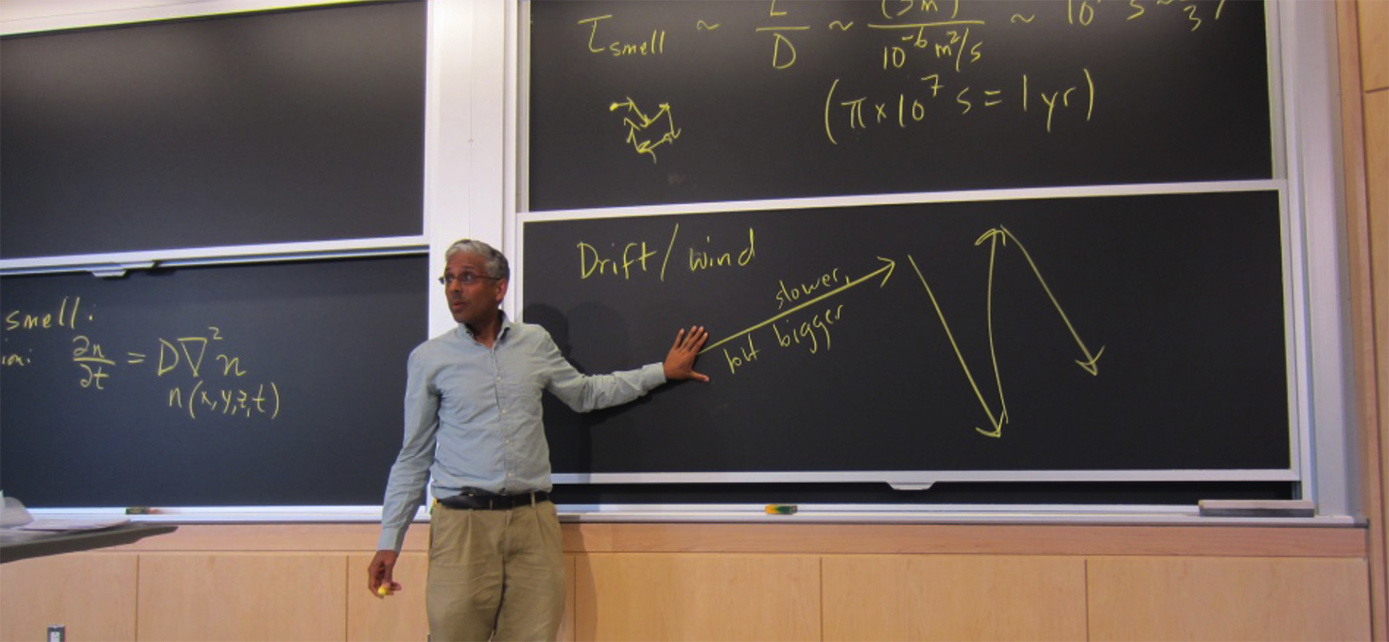Never Calculate Without Knowing the Answer!
-
-
slice.mit.edu
- 6
Filed Under
Recommended

Caption: Sanjoy Mahajan demonstrates how not to calculate answers.
Want to know how new digital technologies and innovative approaches to learning are changing the face of education? One way is to follow the Office of Digital Learning's seminar series, xTalk. You can begin with this excerpt of an xTalk by Sanjoy Mahajan, MIT visiting associate professor of electrical engineering and computer science, reported by undergraduate Yuliya Klochan ’18:
If you've been to a high school math class recently, you probably remember seeing an inordinate number of calculators. You might’ve also observed students entering anything from 999*999 to sin(π/6) to (7-1) into the machines. The calculator habit is so strong that even 5+7 (=12) warrants machine help. And habits die hard.
To combat our calculator obsession, Sanjoy Mahajan suggests a radical departure from the calculator addiction: What if we knew the solution BEFORE the calculation? In Prof Mahajan’s words, “Never calculate without already knowing the answer!” Sounds bizarre, but let him explain, and you will be intrigued.
Sanjoy Mahajan sees a general trend of pragmatism in the United States, with students wishing to just solve the problem without asking the essential how or why. Science problems then become nothing more than a repeated and calculator-assisted application of a single formula. Unfortunately, even the most complex formulas can be wrong. Calculators can’t reveal that, but a better understanding, or insight, of the material can. In his May 19 xTALK, the Art of Insight, Prof Mahajan used several examples to illustrate the benefits to getting to the solution before reaching for a calculator.
EXAMPLE #1: consider being in a room with a paper towel freshly sprayed with perfume (as during Prof. Mahajan’s talk). The question: how long does it take for all audience members to smell the aroma?
Formal Model: Formally, the answer to that ![]() , is derived with a diffusion equation which, according to Prof. Mahajan, is a “big mess” that requires knowledge of calculus. Furthermore, the solved equation tells us that
, is derived with a diffusion equation which, according to Prof. Mahajan, is a “big mess” that requires knowledge of calculus. Furthermore, the solved equation tells us that ![]() is
is ![]() seconds, or approximately ⅓ a year, while, in real life, the back rows smelled the perfume after 30 or so seconds! The official, calculator-enabled model for the problem is way off. Despite the complexity, it fails to provide a reasonable answer.
seconds, or approximately ⅓ a year, while, in real life, the back rows smelled the perfume after 30 or so seconds! The official, calculator-enabled model for the problem is way off. Despite the complexity, it fails to provide a reasonable answer.
Insight: Add to the consideration a four-letter word: wind. With wind, or drift, you can start taking much bigger, though slower, steps to a solution instead of the small and fast steps of the diffusion model. This common-sense model has the benefit of search control: making search space much more tractable by expanding it.
See the full article for more examples.
Let’s recap now to consider all the benefits of reasoning, rather than calculating, the solution.
- Search control (making search space much more tractable by expanding it). Main example: perfume diffusion.
- Transfer (to other problems). Main example: perfume diffusion.
- Use of the (larger) visual cortex. Main example: solar flux.
- Robustness. Main example: solar flux.
- Low entropy/low cognitive load. Main example: well height.
Explore upcoming xTalks, as well as archives of past events with video, audio, and slides. To sign up for the xTalks mailing list.








Comments
Alan Friot
Thu, 08/11/2016 10:24am
Calculators should not be used to teach anything. They should be used to speedup the calculations you know how to do.
Joseph Kozikow…
Wed, 10/19/2016 12:11pm
I taught EE at Villanova U for nearly 50 years. When I started in 1964, I showed my students how to use the slide rule quickly and efficiently to solve AC problems. Later, when 4-function calculators came out, I showed them routines for square root and trig functions. I always emphasized the importance of getting a rough answer before starting calculations. Can the circuit be simplified or approximated? What happens at very high or very low frequencies? I designed my quizzes to give simple answers like 2. But after the new calculators came out, I got 1.9999999.
Bob Atkins
Sun, 08/21/2016 3:05pm
Those of us past a certain age (in my case Course V 1966) remember using a slide rule and how important it was to estimate the magnitude of an answer before doing the calculation.
Alan Friot
Mon, 08/15/2016 10:37pm
First paragraph of a paper I wrote a couple of months ago.
Technology’s Mechanization of Human Beings
The excessive use of the technological products available today is causing our brains to modify. This phenomenon is quite prevalent among persons who are under the age of twenty. Their ability to communicate face to face with one another is virtually nonexistent. The deterioration of our one on one verbal skills is a disaster of great magnitude for the human race.
ilan Samson
Fri, 08/12/2016 5:38pm
The calculator problem has been solved- by way of a new calculator that offers the benefits of calculators but avoids their damage:
The QAMA calculator (scientific) that displays the result only after the user enters a reasonable mental estimate.
Details can be found on www.QAMAcalculator.com
The QAMA calculator exists also as an app (" QAMA calculator ") - for both IOS (Apple) and Android mobile devices (smart phones and tablets)
Bob
Thu, 08/11/2016 3:36pm
Agreed.